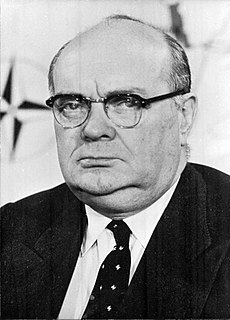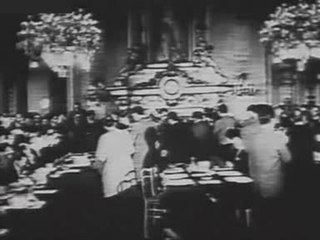Summary
The Spaak Report concluded that a sector-by-sector integration of the European economies would be difficult. Instead, a horizontal integration of the economy, by the gradual elimination of trade barriers, seemed to be the way to continue. The goal was to be achieved by creating a customs union.
On the integration of the energy sectors, there was a different stance for nuclear energy and for hydrocarbon energy sources (oil, coal). The integration of the European nuclear energy sector was desirable because of the costs involved, which surpassed the financial capacity of individual states. The integration of the development of nuclear energy at a supranational level meant more efficient cost sharing for the development of nuclear energy. The integration of hydrocarbon energy sources at a supranational level was less feasible, as these energy sources were managed mainly by multinational companies. The integration of electricity and fuel gas seemed irrelevant, as they were distributed solely at a national level.

The European Coal and Steel Community (ECSC) was an organisation of six European countries created after World War II to regulate their industrial production under a centralised authority. It was formally established in 1951 by the Treaty of Paris, signed by Belgium, France, Italy, Luxembourg, the Netherlands, and West Germany. The ECSC was the first international organisation to be based on the principles of supranationalism, and started the process of formal integration which ultimately led to the European Union.

The European Economic Community (EEC) was a regional organisation that aimed to bring about economic integration among its member states. It was created by the Treaty of Rome of 1957. Upon the formation of the European Union (EU) in 1993, the EEC was incorporated and renamed the European Community (EC). In 2009, the EC's institutions were absorbed into the EU's wider framework and the community ceased to exist.

The European Union is a geo-political entity covering a large portion of the European continent. It is founded upon numerous treaties and has undergone expansions and secessions that have taken it from 6 member states to 27, a majority of the states in Europe.

The Treaty of Rome, officially the Treaty establishing the European Economic Community brought about the creation of the European Economic Community (EEC), the best-known of the European Communities (EC). It was signed on 25 March 1957 by Belgium, France, Italy, Luxembourg, the Netherlands and West Germany and came into force on 1 January 1958. Under the name Treaty on the Functioning of the European Union, it remains one of the two most important treaties in the modern-day European Union (EU).

Paul-Henri Charles Spaak was an influential Belgian Socialist politician, diplomat and statesman. Along with Robert Schuman, Alcide Degasperi and Konrad Adenauer he was a leader in the formation of the institutions that evolved into the European Union.

The European Atomic Energy Community is an international organisation established by the Euratom Treaty on 25 March 1957 with the original purpose of creating a specialist market for nuclear power in Europe, by developing nuclear energy and distributing it to its member states while selling the surplus to non-member states. However, over the years its scope has been considerably increased to cover a large variety of areas associated with nuclear power and ionising radiation as diverse as safeguarding of nuclear materials, radiation protection and construction of the International Fusion Reactor ITER.

The European Communities (EC), sometimes referred to as the European Community, were three international organizations that were governed by the same set of institutions. These were the European Coal and Steel Community (ECSC), the European Atomic Energy Community, and the European Economic Community (EEC); the last of which was renamed the European Community (EC) in 1993 by the Maastricht Treaty, which formed the European Union.
A supranational union is a type of multinational political union where negotiated power is delegated to an authority by governments of member states.

Between 1993 and 2009, the European Union (EU) legally comprised three pillars. This structure was introduced with the Treaty of Maastricht on 1 November 1993, and was eventually abandoned on 1 December 2009 upon the entry into force of the Treaty of Lisbon, when the EU obtained a consolidated legal personality.
- The European Communities pillar handled economic, social and environmental policies. It comprised the European Community (EC), the European Coal and Steel Community, and the European Atomic Energy Community (EURATOM).
- The Common Foreign and Security Policy (CFSP) pillar took care of foreign policy and military matters.
- Police and Judicial Co-operation in Criminal Matters (PJCCM) brought together co-operation in the fight against crime. This pillar was originally named Justice and Home Affairs (JHA)

The Schuman Declaration is a statement made by French foreign minister Robert Schuman on 9 May 1950. It proposed to place French and West German production of coal and steel under one common High Authority. This organization would be open to participation of other Western European countries. This cooperation was to be designed in such a way as to create common interests between European countries which would lead to gradual political integration, a condition for the pacification of relations between them: "Europe will not be made all at once, or according to a single plan. It will be built through concrete achievements which first create a de facto solidarity. The coming together of the nations of Europe requires the elimination of the age-old opposition of France and [West] Germany".

The period saw the first moves towards European unity as the first bodies began to be established in the aftermath of the Second World War. In 1951 the first community, the European Coal and Steel Community was established and moves on new communities quickly began. Early attempts at military and political unity failed, eventually leading to the Treaties of Rome in 1957.

The Château of Val-Duchesse is a mansion and estate situated in the municipality of Auderghem in the Brussels-Capital Region of Belgium. The château, which occupies the site of a former priory, is owned by the Belgian Royal Trust.
Jean V Charles, Count Snoy et d'Oppuers was a Belgian civil servant, diplomat and Christian Democratic politician of the PSC-CVP.

The Messina Conference of 1955 was a meeting of the six member states of the European Coal and Steel Community (ECSC). The conference assessed the progress of the ECSC and, deciding that it was working well, proposed further European integration. This initiative led to the creation in 1957 of the European Economic Community and Euratom.

The Spaak Committee was an Intergovernmental Committee set up by the Foreign Ministers of the six Member States of the European Coal and Steel Community (ECSC) as a result of the Messina Conference of 1955. The Spaak Committee started its work on 9 July 1955 and ended on 20 April 1956, when the Heads of Delegation of the six Member States of the ECSC approved the Spaak report. The committee worked on two main topics, one was the creation of a general common market and the other one was the establishment of a European Community for the peaceful use of atomic energy.

The Intergovernmental Conference on the Common Market and Euratom was held in Brussels and started on 26 June 1956 with a session in the Grand Salon of the Belgian Foreign Ministry. The negotiations went on at the Château of Val-Duchesse in Auderghem (Brussels) and would continue until March 1957. The conference was held to draft the Treaties establishing the European Economic Community (EEC) and the European Atomic Energy Community. The conference built on the results of the Spaak Report of the Spaak Committee and the decision taken at the Venice Conference to prepare the plan for the establishment of a common market and the establishment of a European Community for the peaceful use of atomic energy.
The Spaak method of negotiation is named after Paul-Henri Spaak, a Belgian politician, who applied this method at the Intergovernmental Conference on the Common Market and Euratom in 1956 at Val Duchesse castle in preparing for the Treaties of Rome in 1957.

The Venice Conference was held in Venice on 29 and 30 May 1956. The Foreign Ministers of the six Member States of the European Coal and Steel Community met at the Cini Foundation on the Venetian island of San Giorgio Maggiore to discuss the Spaak Report of the Spaak Committee. At the conference the Foreign Ministers explained the views of the ECSC governments on the proposals in the Spaak Report. As a result of the conference they decided to organize the Intergovernmental Conference on the Common Market and Euratom in order to prepare for establishment of a common market and a European Community for the peaceful use of nuclear power.

The Benelux memorandum of 1955 was a document drafted by the three Benelux countries on 18 May 1955 as a means to reviving European integration on the basis of a general common market.
The Bech-Bodson Ministry was the government of Luxembourg between 29 December 1953 and 29 March 1958. It was a coalition between the Christian Social People's Party (CSV), and the Luxembourg Socialist Workers' Party (LSAP).








